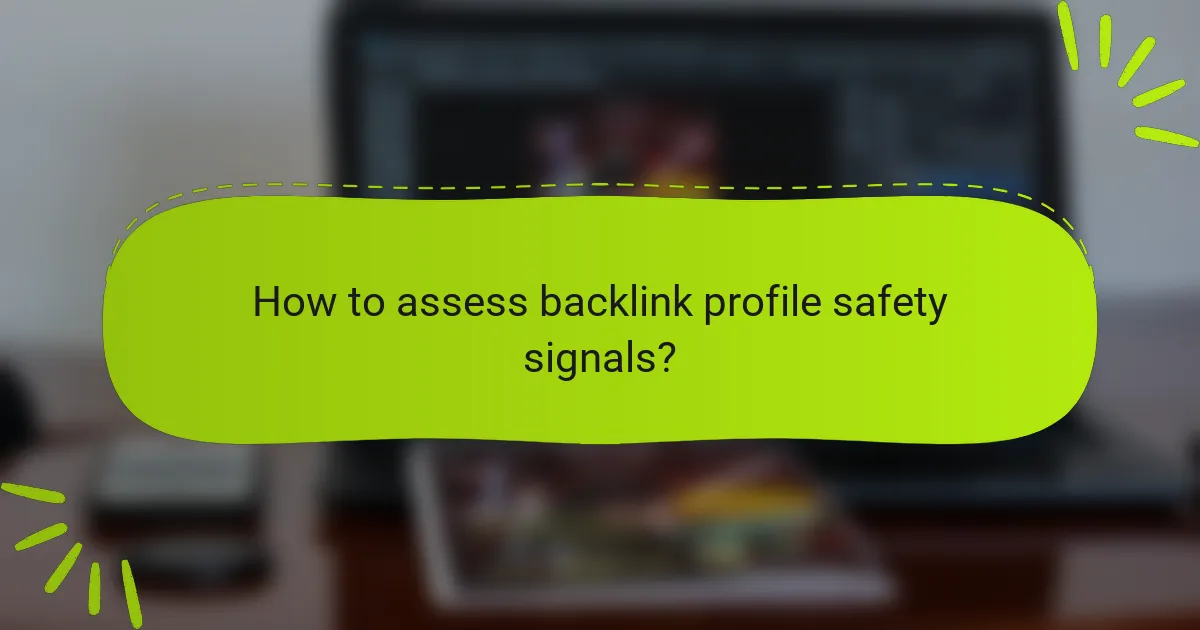Understanding backlink profiles is essential for evaluating a website’s safety signals, trustworthiness, and diversity. By analyzing metrics such as domain authority, spam scores, and link quality, you can assess the overall reliability of a backlink profile. A diverse range of reputable links not only enhances credibility but also minimizes the risk of search engine penalties, ultimately improving a site’s ranking potential.

How to assess backlink profile safety signals?
To assess backlink profile safety signals, focus on metrics that indicate trustworthiness and risk. Evaluating domain authority, spam scores, link quality, anchor text diversity, and historical backlink patterns can help determine the overall safety of a backlink profile.
Domain Authority metrics
Domain Authority (DA) is a score that predicts how well a website will rank on search engines. Generally, a higher DA indicates a more trustworthy site, with scores typically ranging from 1 to 100. Aim for backlinks from sites with a DA of 30 or above for better safety signals.
When assessing DA, consider the context of your niche. A site with a DA of 20 might be more relevant and safer in a specific industry than a site with a DA of 50 in a different field. Use tools like Moz or Ahrefs to check DA scores effectively.
Spam score evaluation
Spam score measures the likelihood of a domain being penalized by search engines. A high spam score, usually above 5%, could indicate potential risks associated with the site. Regularly monitor the spam scores of your backlink sources to avoid harmful links.
To evaluate spam scores, utilize tools like Moz’s Spam Score feature. Focus on backlinks from sites with low spam scores, ideally below 3%, to maintain a healthy backlink profile.
Link quality assessment
Link quality is determined by factors such as relevance, authority, and the context of the linking page. High-quality links come from reputable sites that are relevant to your content. Aim for links from sites that have a good reputation and are well-regarded in your industry.
Consider the placement of the link as well; links embedded in content are generally more valuable than those in footers or sidebars. Regularly audit your backlinks to ensure they meet quality standards.
Anchor text diversity
Diverse anchor text helps create a natural backlink profile and reduces the risk of penalties. A healthy mix of branded, generic, and keyword-rich anchors is ideal. Over-reliance on exact-match keywords can trigger red flags for search engines.
As a rule of thumb, aim for a balanced distribution where branded anchors make up about 30%, generic anchors around 20%, and keyword-rich anchors no more than 50%. This diversity signals to search engines that your backlinks are organic and trustworthy.
Historical backlink analysis
Analyzing the historical backlink profile of a site can reveal patterns that indicate safety or risk. Look for spikes in backlinks that may suggest unnatural link-building practices. Consistent growth over time is a positive sign.
Use tools like Google Search Console or Ahrefs to track historical backlink data. Pay attention to any sudden drops in backlinks, which could indicate penalties or devaluation by search engines, and investigate the causes promptly.

What makes a backlink profile trustworthy?
A trustworthy backlink profile is characterized by links from reputable sources, a natural acquisition process, and consistent growth over time. These elements signal to search engines that a website is credible and valuable, which can enhance its ranking potential.
Reputable referring domains
Links from reputable referring domains are crucial for establishing trustworthiness. These domains typically have high authority, relevance, and a good reputation in their respective industries. For example, a link from a well-known news outlet or a respected industry leader carries more weight than one from a low-quality or spammy site.
To assess the reputation of referring domains, consider metrics such as Domain Authority (DA) or Domain Rating (DR). Aim for links from domains with a DA or DR in the higher ranges, ideally above 30, to ensure credibility.
Natural link acquisition
Natural link acquisition occurs when other websites link to your content organically, without manipulation or artificial means. This can happen through high-quality content that provides value, such as informative articles, infographics, or original research. The more valuable your content, the more likely it is to attract genuine backlinks.
Avoid tactics like buying links or participating in link farms, as these can lead to penalties from search engines. Focus on building relationships with other content creators and engaging in guest blogging to foster natural link growth.
Consistent link growth
Consistent link growth indicates a healthy backlink profile and suggests ongoing interest in your content. Aim for a steady increase in backlinks over time rather than sudden spikes, which can appear suspicious to search engines. A gradual growth pattern helps maintain trust and authority.
Monitor your backlink profile regularly using tools like Ahrefs or Moz to track growth trends. Set realistic goals for acquiring new links each month, such as aiming for a 5-10% increase in quality backlinks, to ensure sustainable development.

How to ensure backlink diversity?
To ensure backlink diversity, focus on acquiring links from a wide range of sources, types, and geographic locations. This approach enhances your website’s credibility and reduces the risk of penalties from search engines.
Variety of link types
Utilizing a variety of link types is crucial for a diverse backlink profile. Aim for a mix of dofollow and nofollow links, as well as links from blogs, forums, directories, and social media platforms. This diversity signals to search engines that your content is valuable across different contexts.
For example, a healthy backlink profile might include links from guest posts, industry-specific directories, and social media shares. Strive for a balanced approach rather than relying heavily on one type of link.
Geographic link distribution
Geographic link distribution refers to obtaining backlinks from various locations. This is particularly important for businesses that operate in multiple regions or countries. A diverse geographic footprint can enhance local SEO and broaden your audience reach.
Consider targeting links from different countries or regions relevant to your market. For instance, if you operate in Europe, aim for backlinks from various EU countries to strengthen your site’s authority across the continent.
Industry relevance
Industry relevance is about acquiring backlinks from websites that are pertinent to your niche. Links from related industries or authoritative sites in your field can significantly boost your site’s trustworthiness. Search engines prioritize context, so relevant links carry more weight.
To achieve this, engage with industry influencers, contribute to relevant forums, and seek partnerships with complementary businesses. This strategy not only improves your backlink profile but also fosters valuable relationships within your industry.

What are the risks of poor backlink profiles?
Poor backlink profiles can lead to significant penalties and a decline in search engine rankings. These risks include algorithmic penalties, negative SEO attacks, and a noticeable drop in organic traffic, all of which can severely impact a website’s visibility and credibility.
Panda penalties
Panda penalties are algorithmic actions taken by search engines to demote sites with low-quality content and poor backlink profiles. Websites that rely on spammy or irrelevant backlinks may find themselves facing these penalties, resulting in a substantial drop in rankings. To avoid Panda penalties, focus on acquiring high-quality backlinks from reputable sources.
Negative SEO attacks
Negative SEO attacks involve malicious efforts to harm a competitor’s website by building low-quality backlinks to it. These harmful links can trigger penalties from search engines, damaging the affected site’s reputation and ranking. To protect against negative SEO, regularly monitor your backlink profile and disavow any suspicious or harmful links.
Loss of organic traffic
A poor backlink profile can lead to a significant loss of organic traffic as search engines may lower a site’s visibility in search results. This decline can occur due to penalties or a drop in trustworthiness perceived by search engines. To mitigate this risk, ensure a diverse and high-quality backlink profile, and actively remove or disavow toxic links that could harm your site’s performance.

How to improve a backlink profile?
Improving a backlink profile involves enhancing the quality, trustworthiness, and diversity of links pointing to your site. This can be achieved through strategic link building, disavowing harmful links, and leveraging content marketing to attract valuable backlinks.
Link building strategies
Effective link building strategies focus on acquiring high-quality backlinks from reputable sources. Consider methods such as guest blogging, where you contribute articles to established websites in your niche, or partnerships with influencers who can share your content.
Additionally, engaging in local sponsorships or community events can help you earn backlinks from local organizations, enhancing your site’s relevance in specific geographic areas. Aim for a diverse range of link sources to strengthen your profile.
Disavow toxic links
Identifying and disavowing toxic links is crucial for maintaining a healthy backlink profile. Toxic links can come from spammy sites or irrelevant sources that may harm your site’s credibility. Use tools like Google Search Console to monitor your backlinks and identify any harmful ones.
Once identified, you can submit a disavow file to Google, instructing them to ignore these links when assessing your site. Regularly reviewing your backlink profile helps prevent potential penalties and keeps your site’s trustworthiness intact.
Content marketing for backlinks
Content marketing is a powerful tool for generating backlinks by creating valuable, shareable content. High-quality blog posts, infographics, and videos can attract attention and encourage other websites to link back to your content.
Consider conducting original research or creating comprehensive guides that provide unique insights. Promote this content through social media and outreach to relevant sites to increase visibility and backlink opportunities. Consistent content creation can significantly enhance your backlink profile over time.

What tools can analyze backlink profiles?
Several tools are available to analyze backlink profiles, helping users assess the quality and diversity of their backlinks. These tools provide insights into trustworthiness, safety signals, and overall link health, enabling informed decisions for SEO strategies.
Safety signals in backlink profiles
Safety signals indicate the reliability of backlinks and their potential impact on a website’s ranking. Tools like Moz and Ahrefs evaluate metrics such as domain authority and spam scores to determine the safety of backlinks. A high domain authority score typically suggests a trustworthy link, while a low spam score can indicate a safer backlink.
When assessing safety signals, look for backlinks from reputable sources, such as established news sites or educational institutions. Avoid links from sites with a history of spam or low-quality content, as these can harm your site’s reputation.
Trustworthiness of backlinks
Trustworthiness refers to the credibility of the sources linking to your site. Tools like SEMrush and Majestic analyze the quality of backlinks based on factors such as relevance and authority. A diverse backlink profile with links from various trusted domains enhances your site’s perceived authority.
To improve trustworthiness, focus on acquiring backlinks from relevant industry websites and influencers. Engaging in guest blogging or partnerships can help secure high-quality links that boost your site’s credibility.
Diversity in backlink profiles
Diversity in backlink profiles is crucial for a balanced SEO strategy. A varied link profile includes backlinks from different types of sources, such as blogs, forums, and social media platforms. Tools like Linkody can help identify the range of sources linking to your site.
Aim for a mix of dofollow and nofollow links to create a natural backlink profile. This diversity not only enhances your site’s authority but also reduces the risk of penalties from search engines. Regularly monitor your backlink profile to ensure it remains diverse and healthy.
